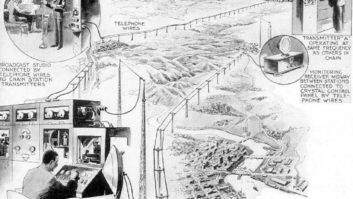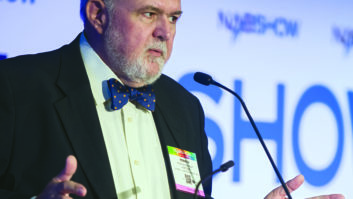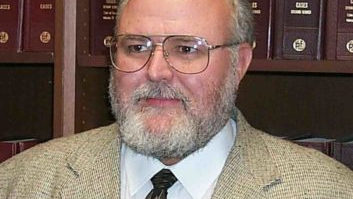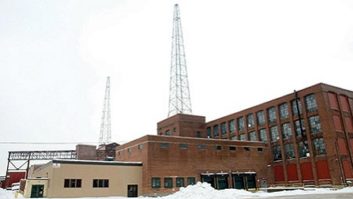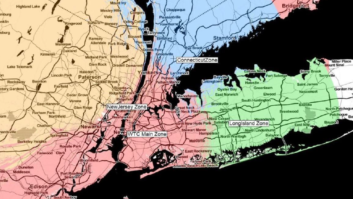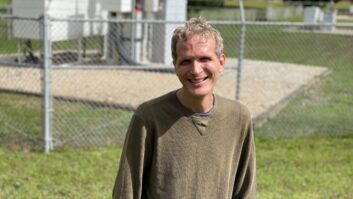Consulting engineer and AM expert Ron Rackley has filed comments with the Federal Communications Commission in the synchronous AM booster proceeding that began this fall.
He is in support of the proposal to allow permanent licensing of AM synchronous booster stations.
Simply stated, our position is that synchronous technology can be a very important vehicle for increasing service to the public by AM stations, Rackley writes.
Read the full text of his comments here.
In the matter of: Amendment of Part 73 to Permit Permanent Licensing of AM Synchronous Booster Stations (RM — 11779)
STATEMENT SUPPORTING PETITION FOR RULEMAKING
The engineering consulting firm of du Treil, Lundin & Rackley, Inc. hereby responds to the Commission’s November 29, 2016 Public Notice requesting statements opposing or supporting the Petition for Rulemaking with regard to the permanent licensing of AM synchronous booster stations. We support the petition and wish to see the possibilities for improving service to the public by AM stations using synchronous technology fully explored in a rulemaking. We believe that ample evidence from the results of many years of experimentation support the adoption of rules to allow permanent licensing of AM synchronous boosters and that modern technological developments with regard to carrier frequency control and precision audio delay make high performance easily within reach for AM synchronous systems.
Simply stated, our position is that synchronous technology can be a very important vehicle for increasing service to the public by AM stations. Stations can use it to add to their coverage areas and, when engineered to not impact other signals interference-wise, their service improvement will come with no down-side for the AM band. Further benefits may be realized if, in the evolution of the AM band, fewer stations remain licensed and therefore new areas of potential service become available for those that remain. Synchronous transmission could be a key factor in optimization of service by stations that may remain economically viable under that scenario. It could be crucial for the survival of the AM broadcasting service into the future.
We strongly agree with the position of the petitioner, Eng. Wifredo G. Blanco-Pi, on synchronous transmission by AM stations. It is a very odd situation where existing synchronous transmission facilities continue to exist because they are authorized for experimental operation over and over again, even though no experimentation is needed to know that the technology works and can be useful for providing improved service. This results, frankly, from the FCC “dropping the ball” and never following through with a rulemaking to authorize synchronous transmission long ago. The time has come to rectify this situation.
It is a mistake to view AM synchronous transmission as only for fill-in service as is the case for FM translators, rather than coverage area extension by an AM station licensee. FM stations are allotted based on a system of spacing between stations rather than contour overlap and interference between stations as is the case for the AM band. If an AM synchronous transmitter can create new service where none exists without creating prohibited groundwave contour overlap or raising nighttime RSS interference at other stations, that should be not only allowed but encouraged.
The history of synchronous transmission dates back to the 1920s when the legendary radio engineering figure Dr. Frank Conrad led a team of Westinghouse engineers in experiments to synchronize transmitters to provide WBZ service over an area plagued with very low ground conductivity in Massachusetts. The technology was very primitive, involving ultrasonic tones that could be sent, but not with 100% reliability, over telephone lines to synchronize transmitter oscillators of novel design. [1]
By the mid-1930s, further experiments had been conducted by others at various other stations. Improved methods for synchronizing carrier frequencies had been developed. Equipment for synchronizing audio signals to correct for delay had been tested and found beneficial for minimizing interference zone signal distortion.[2] The technology, while falling far short of what is possible today, was sufficient to allow reliable operation by the nascent synchronous transmitter facilities of that time.
By the 1940s, methods for synchronous transmission had been perfected to the point where it was coming into routine use. Two well-known synchronous facilities that used the technology to provide directional antenna null fill were WBZ in Boston (with WBZA) and WBT in Charlotte (with WBTA), but there were many other synchronous systems in operation. We believe that the practice would have continued to expand but for one thing, the FCC’s decision to count synchronous transmitters against the limited number of stations a company could own under the rules of that time. Synchronous operation eventually ceased for the stations that had been using it except for, to our knowledge, one facility — that of WLLH in Lowell, Massachusetts with its synchronous transmitter on 1400 kHz in nearby Lawrence, Massachusetts.
When AM improvement was being pursued by the industry and the FCC in the mid-1980s, the idea of synchronous AM transmission resurfaced. Ideas about how new technology might make good quality synchronous operation more readily achievable than had been the case in the past were openly discussed. The FCC decided to authorize experiments with the new technology by allowing the first new synchronous transmitters to be built in decades.
The latest technologies for synchronizing carrier frequencies were evaluated by the newly authorized experimental stations starting in the 1980s and tests were run to explore the improvement in avoiding undesired audio artifacts available with modern audio delay equipment for synchronizing program circuits. It became clear that synchronization was not only possible, but very practical. Two schools of thought developed on synchronization: the absolute synchronization of carrier frequencies such as through use of satellite GPS technology and precision offset of frequencies using very high stability frequency generators. The advantage of the former being to completely eliminate any time varying signal beat product and the advantage of the latter being to replace a constant groundwave standing wave pattern with one where signal out-phasing occurs at a more acceptable interval at any given point in the interference zone. General agreement was reached that digital delay equipment of modest cost can be used to synchronize program audio and minimize delay distortion effects where the signals from two transmitters are close together in amplitude.
While it is impossible to completely eliminate fading zones between synchronized transmitters, it has proven to be practical to use existing, well known technology to minimize their undesirable effects and make it possible to design systems around them to optimize coverage of desired service areas with synchronous transmission.[3] We believe the system in Puerto Rico cited as an example by Eng. Wifredo G. Blanco-Pi to be a good example of the beneficial application of synchronization technology, and that there are a number of others.
It clearly is time to recognize the usefulness of modern synchronous transmitter technology to improve service to the public in the AM band and for the experiments to end. AM synchronous boosters should be permanently licensed.
We believe that FCC regulation of synchronous transmitters should focus on protecting other stations from interference, while giving broadcasters who want to use them maximum flexibility in locating transmitter sites and designing transmitter/antenna combinations to optimize interference zone performance with regard to the audiences they serve. Normal business forces can be relied upon to motivate station licensees to strive for good coverage by synchronous transmitters.
We urge the FCC to propose rules that will allow the existing experimental AM synchronous stations to become permanently licensed and new systems to be built. We believe that the rules should include the following provisions:
- A synchronous system will be defined as multiple transmitters carrying identical (synchronized) audio signals.
- Synchronous operation shall allow either absolutely synchronized carrier frequencies or precision offset operation with equipment sufficiently stable in frequency to maintain them within a tolerance of 0.1 Hz or less if precision offset is desired to minimize standing wave fading zone effects.
- Synchronous systems shall consist of multiple transmitters with normally protected daytime signal level contours that overlap or are contiguous, with nighttime operation authorized even if higher nighttime interference levels result in no joining of interference-free contours. Nighttime-only synchronous transmitters at locations meeting the daytime criteria shall be authorized without regard to whether their nighttime interference-free contours overlap or are contiguous.
- Synchronous systems should be studied for allocations with each transmitter considered individually just as is the case for individual licensed stations. Summing of nighttime RSS limits from transmitters in a synchronous system is inappropriate, as the RSS process accounts for the characteristics of individual skywave signals arriving from separate sources.
- A system of synchronous transmitters, each of which meets all applicable allocations criteria with regard to protecting other stations from interference when considered alone, shall be licensed without regard to extension of the coverage area of the primary station. Extension of overall coverage without interference being produced to any other station is a major objective for synchronous transmission.
- As synchronous transmitters may have intentionally limited coverage areas, no minimum antenna efficiency, height or ground system requirements shall apply to them.
- A synchronous system of transmitters shall count as one station insofar as the ownership requirements FCC rules are concerned.
The commission is urged to consider this matter without delay, as the future of service to the public by AM stations depends on their ability to make changes to improve their overall coverage within the AM band.
Respectfully Submitted,
Ronald D. Rackley, P.E.
du Treil, Lundin & Rackley, Inc.
Consulting Engineers
201 Fletcher Avenue
Sarasota, FL 34237
(941) 329 6000
December 22, 2016
[1] L. McC. Young, Present Practice in the Synchronous Operation of Broadcast Stations as Exemplified by WBBM and KFAB. Proceedings of the I.R.E., vol. 24, pp. 433-436; March, 1936
[2] Ibid., pp. 436-446
[3] George Whitaker, “Case History: Synchronous Broadcasting.” Proceedings of the 1991 SBE Broadcast Engineering Conference, pp. 101-107; September, 1991
A version of this article was originally posted on the website of Radio sister publication Radio World.





